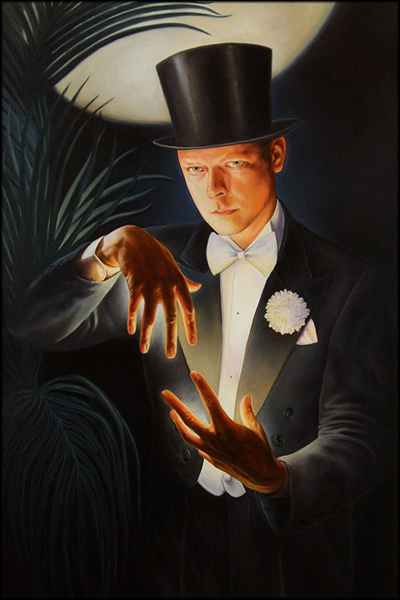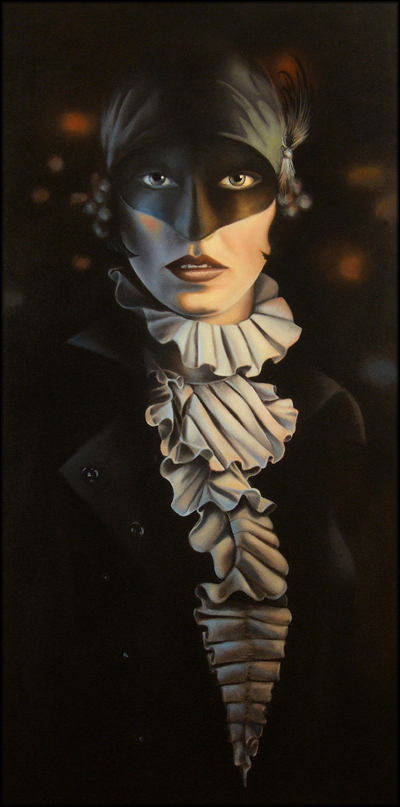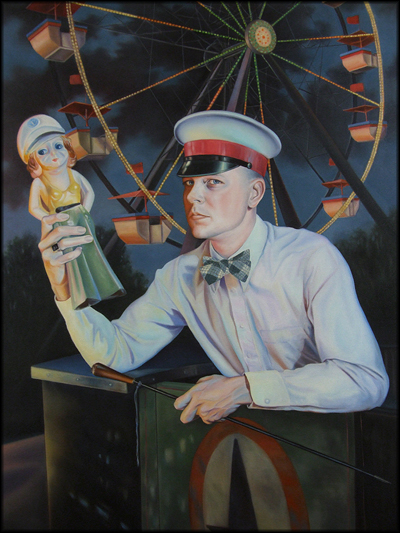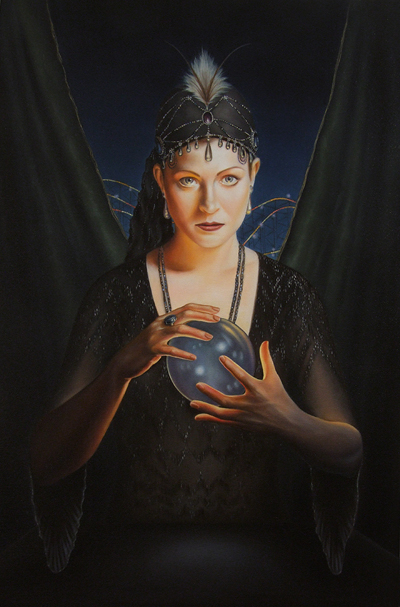Jared Joslin: Stop, Look, and Glisten

“Masquerade Ball” oil on canvas, by Jared Joslin
Jared Joslin’s paintings are gilded portals to the sensual past. Exploring his work, we encounter thriving pockets of nocturnal Weimar nightlife, Dust Bowl era carnivals, and glittering pre-code Hollywood nightclubs. Jared has said that what fuels his vision is “the feeling that you don’t necessarily fit within your own time. You’re drawn to the past in ways you can’t quite understand, but feel the pull of it and want to take on [its] dreams.” His creations truly do seem timeless, and they are dreamy indeed.
Just in time for Jared’s current solo show, “Stop, Look, and Glisten”, Coilhouse is proud to to present Part One of an in-depth interview with this remarkable painter and longtime friend. Part Two of our feature will be more lavishly presented in the impending sixth issue of Coilhouse Magazine. (Hooray, yes, it’s coming soon!)
Comrades, should you be in the Midwest between now and June 18th, be sure to stop by Firecat Projects in Chicago, Illinois. These pieces are a marvel to see in person.
The “Stop, Look, and Glisten” reception is tomorrow evening, (Friday the 27th). More info here.

Set the tone for us, good sir. What music are you listening to? Cocktails? Is your wife (fellow artist, oft-featured friend and correspondent of the ‘Haus) Jessica nearby? What art are you working on, currently? And she?
It’s an unusually beautiful evening for Chicago. The windows are open and a lovely breeze is circulating. Fad Gadget is playing in the studio and I can hear it a tiny bit from the kitchen where I’m working. Jessica is making a good amount of ruckus, drilling holes to inset small brass balls into the horns of a circus goat. She is in the final stages of completing work for her solo show at La Luz de Jesus Gallery next month. Cocktails…yes indeed! How did you know? A lovely Sazerac Rye Manhattan is keeping my blood thin and my gears well lubed. Lately I’ve been working in the studio on some new ideas and approaches, mainly experimenting with watercolors. Currently on the easel is a watercolor painting of myself in Pierrot attire nestling against a costumed lady at a masquerade ball…
You said once, “I love to dream…even as a child, when I was told to go to bed, I had no hesitation, because I loved the life hidden inside of dreams.” And, indeed, while aspects of your paintings are hyper realistic (deep, complex fabric folds, intricate bead/lace/fringework, pellucid skin tones), there’s always this dreamlike, otherworldly quality to the compositions. It can feel a bit itchy, discussing labels… but would you be comfortable calling your work magical realism? Can you tell us, generally, how dreams the subconscious and the intuitive play into your work?
I’m not at ease with labels either, but my work is a form of realism, infused with magic, so I guess magic realism could apply. For me, this kind of visual magic is driven by dreams, the subconscious and the intuitive. They are very closely related and fire from a similar nervous system. I think it’s important not to become too rational or to over think the work, but to listen and allow the work to direct you. With the fear of sounding ridiculous, at times, feel as though I am in a trance while making my work, as if another Jared has taken the wheel. Jessica has often remarked that when I’ve just started a new painting, she will glance over her shoulder, expecting to see a virtually still-white canvas, and a fully realized face and personality is now staring her down. Once I’m reeling in that mode, there is a lovely interaction between the subconscious and intuitive states of being. This wiring is a part of who we are, and creation is one of the vehicles that can pick up that signal. Lucky for me, I have a strong antenna!

“Black Mask” oil on canvas, by Jared Joslin
At what point in your life did you figure out that you wanted to be an artist? Was there a specific moment, a catalyst? Or is art just something you always felt you were meant to do?
I’ve been creative my entire life in one form or another. I drew a lot as a child and conjured up fantasy games that were certainly as involved and creative as composing a painting. I never seriously considered myself an “artist” until I was about 15. In that year, the act of creating revealed itself to me differently. Not to sound to corny here, but it became my means of releasing and projecting inward feelings outward, of manifesting my interior world. At the time, I never knew quite what I was going to get, whether it would be hideous or beautiful or hideously beautiful, but regardless of what it was, it was a revelation of some sort. I wanted to see what was there and look upon that reflection. Once that awareness was born, there was no turning back.
Painting at the level that you do does NOT happen overnight. It’s just like learning the cello, or dancing on pointe. Did you start out with these big representational portraits? Ever go through more abstract phase?
You got that right! It takes thousands upon thousands of nights; many years of trial and error, screw ups, accidents and mistakes. Art school didn’t teach me how to paint, I had to discover that on my own. In school, they encouraged me to be creative and expressive, but discovering the style of artwork that best suits you is always an ongoing journey.
As many young artists do, I started out by mimicking other people’s work. Not only artists from magazines, books and album covers, but also older artist friends, teachers and even my parents. I had to try on their clothes, so-to-speak, to see how their visual language would fit. As a result, I ended up with quite the hodgepodge of imagery, but at least I was experimenting and searching. The incentive of going to art school was knowing that exploration would continue, and that it would continue to expand in scope.

“Blonde Venus” oil on canvas, by Jared Joslin
A little known (lapsed?) medium you’ve worked in is woodcutting. Would love to hear a bit about that.
I started making woodcarvings around 1989, when I was a teenager, still living at home in Colorado. A close friend of mine made lovely and beautifully crafted wooden boxes that were embellished with carvings and bits of bone inlay. He used a Dremel tool for carving, and when I saw its possibilities, I quickly ran to the hardware store to get one for myself! The subtractive approach to form completely shifted my way of thinking. Each step of the process had to be executed precisely, or the entire sculpture could be ruined, and I enjoyed that challenge. My early carvings were elaborately carved wooden canes, depicting grinning demons, hybrid rabbits, maniacal monkeys, hypnotic clowns and saucy fetish girls. Once the wood carving was finished and painted, I would usually integrate other elements, like bone buttons for the clown, or porcelain teeth for the grimacing monkey. I worked with woodcarving all through my college days, although no one ever really knew about it and I continued making them until around 1998.
When I first began exhibiting, the gallery would be full of paintings, drawings and woodcarvings. People would often see my shows and assume that the work was done by multiple artists! This confusion really made me stop and reconsider my approach. One evening, while I was out for sushi with Jessica, the realization that I needed to specialize hit me like a hammer. From that point onward, I knew that I needed to devote myself entirely to painting and to focus on making cohesive bodies of work for my exhibitions.
With that said, my most cherished carving from that time period is a piece that I still consider a masterwork. It is a 4 foot tall antelope-woman hybrid, which took me close to a year to complete. She has muscular, highly defined, deer-like legs that are long and lean and taper down to smooth, sharp black hooves. Her torso is human, slender and elegant, with pronounced genitals and up-turned breasts. Atop her head, are sickle shaped horns and an elaborate Geisha-like hairdo that looks like it could shoot missiles. Her hands are cupped in front of her body as though concealing a secret. The head is turned to the side and she has piercing wild eyes that will haunt your dreams. I imagine her as a nocturnal creature, partly because I first imagined her while in the forest, late at night, on an owl and moth watching adventure in Kankakee, Illinois. In my vision, she was fleeting and fast as hell, with brilliant cold eyes, as she captured and fed off moths. I named her White Kneed Moth Catcher.

“Carny Self Portrait” oil on canvas, by Jared Joslin
Do you base your palette (or working methodology) on any particular tradition? For example, some artists maintain a 19th century palette while others may rely entirely on a Renaissance egg tempera approach, whereas any number of your pieces could easily be mistaken for work made in the ’20s or ’30s…
I do have a very specific way of organizing my paint on the palette, but it’s come about more from my personal experiences and preferences than from a specific textbook or historical tradition. It is highly important to understand how the paints and colors will work together. There are definitely friends and foes on the palette, and not understanding their nature can lead to a muddy, unforgivable mess.
As much as you thrive on the process, there’s also a compulsive side to painting as relentlessly as you do. Additionally, you work on a fairly epic scale; some of your paintings are 6 feet tall or more! You must get overwhelmed, sometimes. Or no? Ever suffer an artistic block, or any physical impediments? If so, how do you cope?
Oh it’s definitely compulsive, especially considering that I’ve been making art like a crazy fiend for over half my life, some 25 years now! Art making can take over your life, which isn’t necessarily a bad thing, but there has got to be a balance between that and finding other things you enjoy. After mixing things up a bit, going back to the studio feels invigorating. I tend to get overwhelmed when I’m pressured to make work fast, or if I have to make a deadline. I know that many artists thrive on that sense of urgency, but I like to make work on my own time and schedule.
There are times when I feel hit with an artistic block. I either try to work through it, or I move on to something different, like looking through books and gathering inspiration from images or words, things that get my imagination reeling again.
As far as physical impediments, yes, I have a serious visual impairment in my left eye that is known as Central Serous Retinopathy (CSR). It causes blurred and distorted vision and a ‘sun spot’ in my direct field of vision. Basically, a big gray blob partially obscures my sight, with varying degrees of intensity. I’ve lived with this condition since I was 24, and it can certainly interfere with my work. I just pray nothing ever happens to my strong right eye, which allows me to ‘see past’ these distortions. In my painting Artist and Muse, a portrait of Jessica and I, I refer to this condition though the gesture. Jessica is standing beside me, and with gloved hand, holding my bad eye open wide as if to help me see.

“Shooting Gallery” oil on canvas, by Jared Joslin
What are some of your favorite silent films? Books from the early 20th century? Fashion designers? Actors? Actresses? Entertainers? Etc?
I loved watching Louise Brooks in Diary of a Lost Girl by G.W. Pabst. Fritz Lang’s Metropolis is so visually lush, it sets the standard. Also loved watching Lon Chaney as an ‘armless’ knife thrower with Joan Crawford in Tod Browning’s, The Unknown.
As far as writers go, I’m a big fan of George Bataille. In particular, Story of the Eye and Madame Edwarda. Actually, we have several of Hans Bellmer’s original etchings from Madame Edwarda in our personal collection. Truly amazing images that I’ve admired for many years, but never thought I’d have the chance to live with! I also enjoy reading the Brothers Grimm fairy tales.
I think the fashion designs of the 1930s Hollywood glamour are lovely, I especially like the costumes done by Adrian and Irene.
For actors, I find James Cagney’s early performances highly entertaining. He dished out some killer one liners! Clark Gable is also lots of fun, especially when he’s teamed up with hotties like Jean Harlow and Claudette Colbert! Love almost all of the Fred and Ginger films. They always brighten my day and I’ve seen most of them dozens of times.
Musicians: I love to listen to swing, Louis Armstrong, Artie Shaw, Duke Ellington and Count Basie. I also really like German cabaret songs from Marlene Dietrich, Greta Keller, and The Comedian Harmonists.
Interviewing Jessica a few years back, Coilhouse asked which six guests (living or dead) she would invite to a lavish dinner party. You were first on her list, natch, in addition to Hans Bellmer, Lee Bontecou, David Lynch, Tom Waits, and Matthew Barney. There are six more places at your table. Who else is coming to dinner?
This is a fun question and quite a fantasy. Let’s invite four dames and two gents. Marlene Dietrich, Marilyn Monroe,Tamara de Lempicka, PJ Harvey, Otto Dix and Louis Armstrong.

“The Fortune Teller” oil on canvas, by Jared Joslin

May 26th, 2011 at 9:27 pm
Amazing work as per usual from Jared.